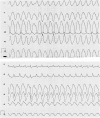Prevalence and clinical relevance of the morphological substrate of ventricular arrhythmias in patients without known cardiac conditions detected by cardiovascular MR
- PMID: 24712323
- PMCID: PMC4075562
- DOI: 10.1259/bjr.20140059
Prevalence and clinical relevance of the morphological substrate of ventricular arrhythmias in patients without known cardiac conditions detected by cardiovascular MR
Abstract
Objective: Cardiac MR (CMR) identifies the substrate of ventricular arrhythmia (VA) in cardiomyopathies and coronary heart disease. However, little is known about the value of CMR in patients with VA without previously known cardiac disorders.
Methods: 76 patients with VA (Lown ≥2) without known cardiac disease after regular diagnostic work-up were studied with CMR, and findings were correlated with electrocardiogram (ECG) and electrophysiological stimulation (EPS). Structural abnormalities matching the VA origin as defined by ECG and/or EPS, or a CMR-detected cardiac condition known to cause arrhythmia were defined as VA substrate. CMR findings were defined as clinically relevant, if resulting in a new diagnosis, change of treatment or additional diagnostic procedure.
Results: 44/76 patients demonstrated pathological CMR findings. In 24/76 patients, the pathology was detected by CMR and not by echocardiography. CMR-based diagnoses of cardiac disease were established in 20/76 patients, and all were morphological substrates for VA. In seven patients, the location of the CMR finding (scar) directly matched the VA origin. CMR findings resulted in a change of treatment in 21 patients and/or additional diagnostics in 8 patients.
Conclusion: Undetected cardiac conditions are frequent causes of VA. This is the first study demonstrating the value of CMR for detection of morphological substrate and/or underlying cardiac disorders in VA patients without known cardiac disease.
Advances in knowledge: The high incidence of clinically relevant CMR findings which were not detected during initial diagnostic work-up strongly supports the use of CMR to screen VA patients for underlying heart disease.
Figures





References
-
- Boye P, Abdel-Aty H, Zacharzowsky U, Bohl S, Schwenke C, van der Geest RJ, et al. . Prediction of life-threatening arrhythmic events in patients with chronic myocardial infarction by contrast-enhanced CMR. JACC Cardiovasc Imaging 2011; 4: 871–9. - PubMed
-
- Moon JC, McKenna WJ, McCrohon JA, Elliott PM, Smith GC, Pennell DJ. Toward clinical risk assessment in hypertrophic cardiomyopathy with gadolinium cardiovascular magnetic resonance. J Am Coll Cardiol 2003; 41: 1561–7. - PubMed
-
- Yan AT, Shayne AJ, Brown KA, Gupta SN, Chan CW, Luu TM, et al. . Characterization of the peri-infarct zone by contrast-enhanced cardiac magnetic resonance imaging is a powerful predictor of post-myocardial infarction mortality. Circulation 2006; 114: 32–9. - PubMed
MeSH terms
LinkOut - more resources
Full Text Sources
Other Literature Sources
Medical

